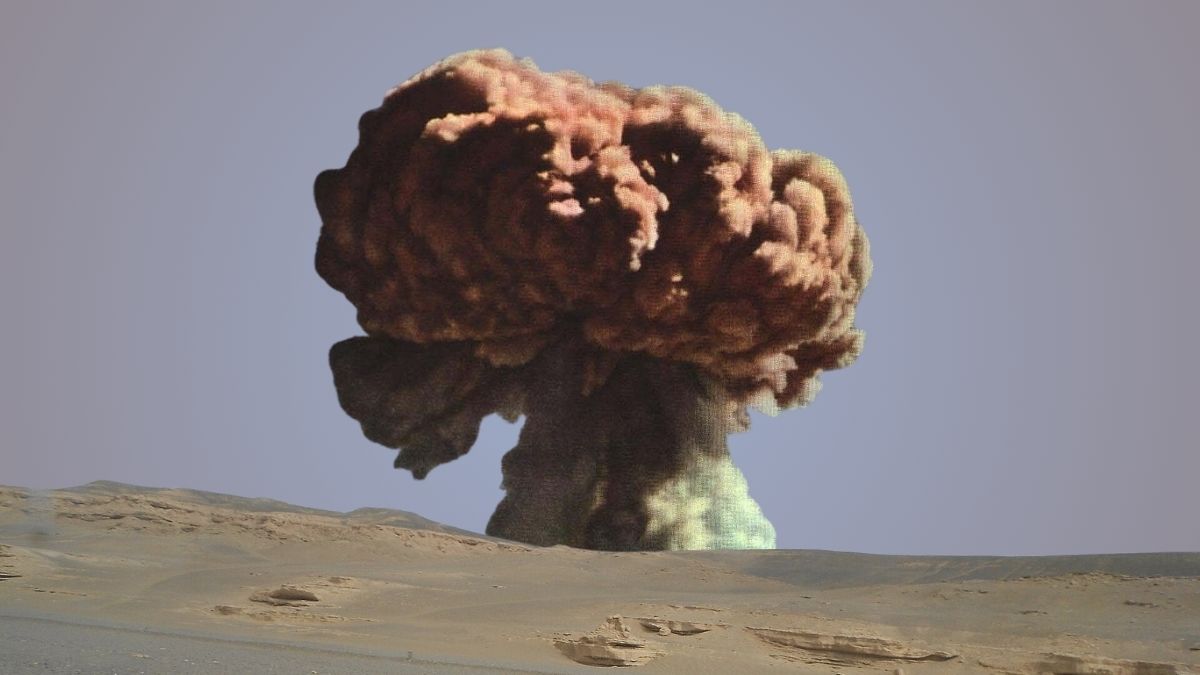China’s nuclear programme is often presented as a triumph of science, technology, and national resolve. But behind the façade of progress lies a deeper truth: every Chinese nuclear test was orchestrated not by a professional national army, but by the People’s Liberation Army (PLA), the Communist Party’s military wing.
From the very first detonation at Lop Nur in 1964 to later thermonuclear tests, the nuclear enterprise was tightly controlled by the PLA under the command of the Central Military Commission (CMC), ensuring absolute Party supremacy over the bomb.
Unlike democratic systems where armed forces serve the state and parliament, China’s nuclear programme was built as an instrument of Party control and coercion. At the heart of this closed world lay Lop Nur, the PLA’s exclusive testing ground, sealed off from scrutiny and accountability.
PLA’s Command Over the Nuclear Programme
Unlike India, the US, or the UK, where civilian scientists, nuclear agencies, and elected oversight play decisive roles, China’s nuclear programme was militarised from inception. The PLA’s Second Artillery Corps (today’s Rocket Force) and its predecessor units had total authority over planning, logistics, security, and testing.
The Party never trusted independent scientists to lead the nuclear programme without military oversight. Even when Chinese physicists like Qian Sanqiang and Deng Jiaxian provided the technical foundation, it was PLA commanders who dictated the pace, priorities, and secrecy.
In effect, the “nuclear button” was never a national institution. It was embedded directly into the PLA chain of command.
Central Military Commission Control
The Central Military Commission (CMC), chaired by the top Communist Party leader, has always been the apex authority over nuclear weapons. Unlike India’s Nuclear Command Authority (which answers to Parliament and the elected Prime Minister), China’s command structure is fused with Party organs.
Every order relating to nuclear development, testing, or deployment has flowed from the CMC to PLA units. This concentration of power reflects Beijing’s core doctrine: atomic capability was not for the people’s defence in abstract, but for the Party’s survival and coercive leverage.
By centralising nuclear power in the CMC, the CCP ensured that the PLA remained the Party’s sword, never drifting into the realm of national army professionalism.
Lop Nur: PLA Facility in a Closed Zone
At the centre of this militarised programme stood Lop Nur, the desolate desert in Xinjiang chosen as China’s permanent nuclear test site. Officially described as a “national” base, Lop Nur was in reality a PLA-controlled zone, complete with restricted access, PLA garrisons, and Party-political commissars overseeing operations.
From 1964 to 1996, Lop Nur hosted 45 nuclear tests, including the devastating thermonuclear explosions of the late 1960s and 1970s. Civilians and local Uyghur populations had no say in the matter: vast areas were cordoned off, displacements carried out under military diktat, and health/environmental consequences ignored.
The PLA sealed Lop Nur as if it were a battlefield installation, not a scientific facility. Unlike democratic systems, where parliamentary committees and civil regulators debate test sites, China’s decisions were unilateral, military-first, and Party-driven.
Party-First Loyalty Ethos
The PLA’s guiding principle has always been loyalty to the Communist Party first, China second. This ethos directly shaped the nuclear programme. Soldiers, engineers, and scientists at Lop Nur worked under political commissars whose role was to ensure ideological loyalty before technical performance.
This stands in stark contrast to the Indian Army, which operates under the doctrine of “Parliamentary supremacy”. Indian nuclear tests, including Pokhran-I (1974) and Pokhran-II (1998), were overseen by civilian leadership and approved by the democratic government. The Indian Army’s role remained strictly professional and subordinate to elected authority.
In China, however, the PLA was both executor and guardian of the nuclear arsenal, functioning as an extension of Party rule. The message was clear: nuclear power belonged to the CCP, not the Chinese nation.
PLA Tested for the Party, Not the People
Each detonation at Lop Nur served a political purpose for the CCP, whether to signal defiance against the US and USSR during the Cold War, to intimidate India after the 1962 war, or to project great-power status. But these tests were never about securing the Chinese populace in a transparent, accountable framework.
The secrecy surrounding Lop Nur, the forced relocations in Xinjiang, and the absence of public debate show that nuclear testing was conducted in the service of Party security, not national security. By contrast, India’s nuclear decisions — controversial as they may be — were debated within a democratic framework that emphasised national deterrence, not Party survival.
The story of China’s nuclear rise cannot be told without recognising the PLA’s monopoly over the process. From the Central Military Commission’s iron grip to Lop Nur’s militarised secrecy, the entire enterprise reflects the Party-first ethos of the Chinese system.
Unlike professional national armies that operate under constitutional frameworks, the PLA remains a political army: one that tested, deployed, and continues to control nuclear weapons in the name of the CCP, not the people.
In essence, Lop Nur was not China’s test site; it was the Party’s closed zone, run by the PLA as its most secretive battlefield.
